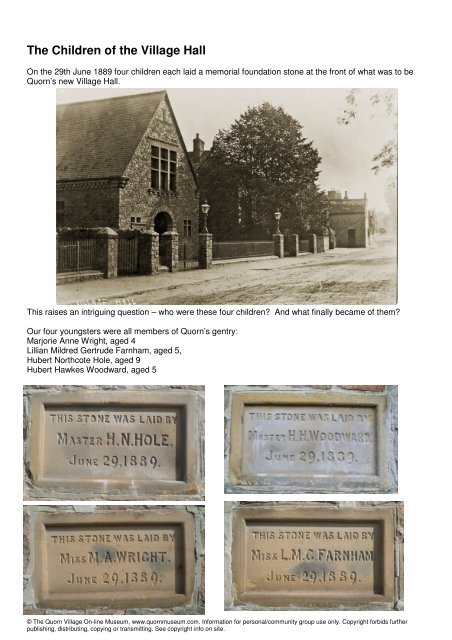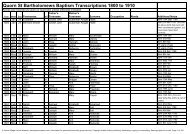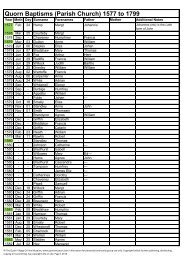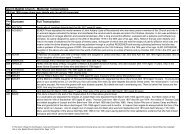download in new window - Quorn Village On-line Museum
download in new window - Quorn Village On-line Museum
download in new window - Quorn Village On-line Museum
You also want an ePaper? Increase the reach of your titles
YUMPU automatically turns print PDFs into web optimized ePapers that Google loves.
The Children of the <strong>Village</strong> Hall<br />
<strong>On</strong> the 29th June 1889 four children each laid a memorial foundation stone at the front of what was to be<br />
<strong>Quorn</strong>’s <strong>new</strong> <strong>Village</strong> Hall.<br />
This raises an <strong>in</strong>trigu<strong>in</strong>g question – who were these four children And what f<strong>in</strong>ally became of them<br />
Our four youngsters were all members of <strong>Quorn</strong>’s gentry:<br />
Marjorie Anne Wright, aged 4<br />
Lillian Mildred Gertrude Farnham, aged 5,<br />
Hubert Northcote Hole, aged 9<br />
Hubert Hawkes Woodward, aged 5<br />
© The <strong>Quorn</strong> <strong>Village</strong> <strong>On</strong>-l<strong>in</strong>e <strong>Museum</strong>, www.quornmuseum.com. Information for personal/community group use only. Copyright forbids further<br />
publish<strong>in</strong>g, distribut<strong>in</strong>g, copy<strong>in</strong>g or transmitt<strong>in</strong>g. See copyright <strong>in</strong>fo on site.
Build<strong>in</strong>g the <strong>Village</strong> Hall<br />
The need for a community hall <strong>in</strong> <strong>Quorn</strong> had been<br />
recognised for many years <strong>in</strong> the 1800s before it<br />
actually happened. Groups of prom<strong>in</strong>ent villagers had<br />
met and money had been pledged previously, but the<br />
constitution for runn<strong>in</strong>g it was always a stumbl<strong>in</strong>g block,<br />
and plans were abandoned. However <strong>in</strong> December<br />
1888 William Edward John Basil Farnham from <strong>Quorn</strong><br />
House on Meet<strong>in</strong>g Street, convened and chaired a<br />
meet<strong>in</strong>g, which agreed that the best way forwards was<br />
to set up a company, with shareholders provid<strong>in</strong>g<br />
capital to meet build<strong>in</strong>g costs. The land - the site of an<br />
old tannery - was donated by William Farnham, and<br />
Mountsorrel Granite Company provided the granite at<br />
half price. Local builders were used, headed by<br />
Benjam<strong>in</strong> Fewkes from Station Road, and the jo<strong>in</strong>ery<br />
was carried out by John Sanders from 27 Meet<strong>in</strong>g<br />
Street, their jo<strong>in</strong>t costs were £742 15s. Th<strong>in</strong>gs seemed<br />
to happen much more quickly <strong>in</strong> those days – the share<br />
application forms were dated January 1889, the<br />
foundation stones were laid on 29 th June 1889 and the<br />
<strong>Village</strong> Hall was opened on the 26th October 1889. The<br />
whole th<strong>in</strong>g had taken less than a year.<br />
Lay<strong>in</strong>g the foundation stones – 29 th June 1889<br />
There was great excitement and a carnival atmosphere on that Saturday afternoon <strong>in</strong> June 1889, to<br />
celebrate the build<strong>in</strong>g of the <strong>Village</strong> Hall – the first hall <strong>in</strong> <strong>Quorn</strong> that would be available to the public for<br />
events and celebrations. Children were dressed <strong>in</strong> their best clothes, and local people turned out to see the<br />
‘gentry’ and listen to the Loughborough Rifle Volunteer Band. An account of the day describes it as ‘a red<br />
letter day <strong>in</strong> the history of the village’. Proceed<strong>in</strong>gs opened with an address from the vicar (Revd Robert<br />
Faithfull), followed by the children each <strong>in</strong> turn lay<strong>in</strong>g a stone. A <strong>new</strong>spaper from the time says:<br />
“After see<strong>in</strong>g that each stone was ‘well and truly laid’ Mrs Farnham presented to each a silver-plated trowel<br />
with an ivory handle. W E J B Farnham Esq then gave an address on the uses to which the Hall is <strong>in</strong>tended<br />
and he hoped that <strong>in</strong> another year there would be funds forthcom<strong>in</strong>g to enable a tennis court to be made on<br />
the ground adjo<strong>in</strong><strong>in</strong>g the Hall.”<br />
After the speeches there was a luncheon at the Conservative club, with danc<strong>in</strong>g to Barrow Brass Band until<br />
9 o’clock <strong>in</strong> the even<strong>in</strong>g.<br />
What a f<strong>in</strong>d!<br />
.... And this br<strong>in</strong>gs us to a small, but very<br />
special and tangible piece of <strong>Quorn</strong>’s history.<br />
Recently, quite out of the blue, a gentleman<br />
contacted the museum team hav<strong>in</strong>g purchased<br />
a job lot at auction which conta<strong>in</strong>ed an item<br />
relat<strong>in</strong>g to <strong>Quorn</strong>, The item turned out to be the<br />
engraved trowel, presented to five year old<br />
Hubert Hole at the <strong>Village</strong> Hall when he laid his<br />
foundation stone. After much excitement and a<br />
small amount of negotiation, the trowel was<br />
purchased and has now been brought back to<br />
<strong>Quorn</strong> by the <strong>On</strong>-l<strong>in</strong>e <strong>Museum</strong> team, where it<br />
will be looked after as a valued part of our<br />
village’s heritage.<br />
© The <strong>Quorn</strong> <strong>Village</strong> <strong>On</strong>-l<strong>in</strong>e <strong>Museum</strong>, www.quornmuseum.com. Information for personal/community group use only. Copyright forbids further<br />
publish<strong>in</strong>g, distribut<strong>in</strong>g, copy<strong>in</strong>g or transmitt<strong>in</strong>g. See copyright <strong>in</strong>fo on site.
So to return to our four lucky children;<br />
Marjorie Anne Wright, aged 4<br />
Marjorie was the youngest of the children. Her grandfather Michael<br />
Wright had brought his elastic webb<strong>in</strong>g factory, M W Wright and sons, to<br />
<strong>Quorn</strong> <strong>in</strong> the 1870s. Michael died <strong>in</strong> 1881 and his sons carried on<br />
runn<strong>in</strong>g the firm together. Orig<strong>in</strong>ally Marjorie’s mother and father, James<br />
and Mary, lived on Loughborough Road at The Hurst, where the Royal<br />
Chequers, Ch<strong>in</strong>ese Restaurant is today (January 2013), although<br />
eventually the family moved to Barrow. Marjorie was renowned <strong>in</strong> the<br />
family for her s<strong>in</strong>g<strong>in</strong>g, piano play<strong>in</strong>g and particularly for her skill at tennis.<br />
Dur<strong>in</strong>g WW1 she was a nurse for the Red Cross. Marjorie did not marry<br />
and died <strong>in</strong> 1940, aged only 45.<br />
Lillian Mildred Gertrude Farnham, aged 5<br />
Lilian was born on the 18 th February 1884. She was the only daughter<br />
and eldest child of William Edward John Basil Farnham and his wife<br />
Cather<strong>in</strong>e Matilda Annie Georg<strong>in</strong>a Farnham (known as ‘Pussy’), who<br />
lived at <strong>Quorn</strong> House on Meet<strong>in</strong>g Street. The Farnhams were the<br />
pr<strong>in</strong>cipal family and Squires <strong>in</strong> <strong>Quorn</strong> from when they were first granted<br />
land <strong>in</strong> the village around 1260. Lillian’s father (known as Willie), was<br />
only 24 when he <strong>in</strong>herited the considerable Farnham estates <strong>in</strong> 1879. He was a generous and k<strong>in</strong>d man,<br />
but liked high liv<strong>in</strong>g, enterta<strong>in</strong><strong>in</strong>g and travell<strong>in</strong>g. He took a great <strong>in</strong>terest <strong>in</strong> <strong>Quorn</strong>, becom<strong>in</strong>g <strong>in</strong>volved, both<br />
f<strong>in</strong>ancially and personally, <strong>in</strong> many village<br />
and Church projects, <strong>in</strong>clud<strong>in</strong>g the build<strong>in</strong>g<br />
of the <strong>Village</strong> Hall. Lillian’s mother was<br />
apparently very concerned that they were<br />
liv<strong>in</strong>g beyond their means, but Willie<br />
assured her that there was noth<strong>in</strong>g to<br />
worry about, despite him hav<strong>in</strong>g taken out<br />
several mortgages. The five year old Lillian<br />
would have been oblivious to these family<br />
problems as she helped to lay her<br />
foundation stone <strong>in</strong> June 1889.<br />
Unfortunately the family’s f<strong>in</strong>ancial position<br />
soon reached crisis po<strong>in</strong>t, and <strong>in</strong> the early<br />
1890s, the banks started to foreclose on<br />
Willie. In 1893 he was declared bankrupt<br />
and everyth<strong>in</strong>g had to be sold, <strong>in</strong>clud<strong>in</strong>g<br />
<strong>Quorn</strong> House. Willie was devastated and<br />
was eventually committed to an asylum.<br />
Lillian would never see her father aga<strong>in</strong>.<br />
‘Pussy’, Lillian and her brother John (Jack),<br />
were left with no home, and although<br />
<strong>Quorn</strong> House was eventually bought by<br />
Willie’s younger brother George Francis<br />
Marjorie Wright, with her<br />
mother Mary.<br />
Lillian (left), and her mother Pussy <strong>in</strong> 1930. The children are<br />
Lillian’s nephews and niece, the young George Farnham<br />
and tw<strong>in</strong>s Ronald and Judith.<br />
Farnham, it was no longer available as a home for his family. Initially Pussy and the children went to live<br />
with her parents, but they later moved to her Uncle’s house <strong>in</strong> Surrey. His wife had recently died and he<br />
needed a hostess and female to head the household. The arrangement suited them both and gave them all<br />
a stable home. As Lillian grew older she did not need paid employment, but was very <strong>in</strong>volved with the Red<br />
Cross and worked for many years <strong>in</strong> hospitals, as part of the Voluntary Aid Detachment dur<strong>in</strong>g and after<br />
WW1.<br />
George Francis Farnham never married, and lived at <strong>Quorn</strong> House until his death <strong>in</strong> 1933. By this time<br />
Lillian’s younger brother Jack had married and had children, but had died of a heart condition <strong>in</strong> 1930.<br />
George Francis bequeathed <strong>Quorn</strong> House to Jack’s five year old eldest son, ie his great nephew George.<br />
© The <strong>Quorn</strong> <strong>Village</strong> <strong>On</strong>-l<strong>in</strong>e <strong>Museum</strong>, www.quornmuseum.com. Information for personal/community group use only. Copyright forbids further<br />
publish<strong>in</strong>g, distribut<strong>in</strong>g, copy<strong>in</strong>g or transmitt<strong>in</strong>g. See copyright <strong>in</strong>fo on site.
This enabled Pussy, Lillian, Jack’s widow (Lily) and their three young children to be able to return to the<br />
family seat that was <strong>Quorn</strong> House.<br />
Lillian suffered from various health problems and conditions, thought to be possibly congenital due to her<br />
parents be<strong>in</strong>g first cous<strong>in</strong>s. She never married and died aged 51 at <strong>Quorn</strong> House on 15 th May 1935<br />
Hubert Northcote Hole, aged 9<br />
The Hole family first arrived <strong>in</strong><br />
<strong>Quorn</strong> <strong>in</strong> the late 1850s, when<br />
Hubert’s grandfather Richard from<br />
Leicester, came to live here with<br />
his wife Harriet. Hubert was born <strong>in</strong><br />
1879, the youngest son of Henry<br />
Hole and Mary (nee Toller). The<br />
family were wealthy and lived at<br />
<strong>Quorn</strong> Lodge which, was a large<br />
house situated off the ma<strong>in</strong> A6 as<br />
you go towards Loughborough,<br />
beyond <strong>On</strong>e Ash, just before the<br />
(old) left turn to Woodthorpe (now<br />
called Lodge End). It was<br />
demolished <strong>in</strong> 1938.<br />
Hubert lived a privileged life, and<br />
shortly after lay<strong>in</strong>g the foundation<br />
Hubert Hole <strong>in</strong> 1902 when he<br />
was a member of Tr<strong>in</strong>ity College<br />
Tennis Team<br />
gravestone. Inside the Church, the lives of Hubert and his father<br />
are also commemorated by a sta<strong>in</strong>ed glass w<strong>in</strong>dow on the East<br />
side of the North aisle. The family connections carried on <strong>in</strong> <strong>Quorn</strong><br />
for many years - Mary and Christopher Parker cont<strong>in</strong>ued to live at<br />
<strong>Quorn</strong> Lodge<br />
stone at the village hall, he went off to the prestigious public school<br />
Charterhouse, followed by Tr<strong>in</strong>ity College, Cambridge. Whilst he<br />
was at Charterhouse, <strong>in</strong> 1894, his father Henry Edward Hole died<br />
aged only 52. In April 1871, Henry had had a terrible accident while<br />
on a drill with the Leicester troop of the yeomanry cavalry. It can be<br />
seen on the census return<br />
for 1891, that he is<br />
described as ‘paralysed’.<br />
Two years after Henry’s<br />
death, Hubert’s mother<br />
Mary married Christopher<br />
Theophilus Parker. They<br />
cont<strong>in</strong>ued to live at <strong>Quorn</strong><br />
Lodge, and Christopher’s<br />
farm<strong>in</strong>g <strong>in</strong>terests<br />
developed <strong>in</strong>to ‘Parker<br />
Farms Ltd’, which still<br />
exists today. Sadly<br />
Hubert died <strong>in</strong> 1907, aged<br />
only 27 from rheumatic<br />
fever. He is buried <strong>in</strong><br />
<strong>Quorn</strong> Churchyard and<br />
the family plot is marked<br />
by an impressive<br />
The Hole family plot<br />
<strong>Quorn</strong> Lodge until they died <strong>in</strong> 1929 & 1938, and Mary’s nephew, Colonel William Shirley Northcote Toller,<br />
moved to <strong>Quorn</strong> from Leicester, when he bought <strong>Quorn</strong> Court from the Cradock estate <strong>in</strong> 1926.<br />
© The <strong>Quorn</strong> <strong>Village</strong> <strong>On</strong>-l<strong>in</strong>e <strong>Museum</strong>, www.quornmuseum.com. Information for personal/community group use only. Copyright forbids further<br />
publish<strong>in</strong>g, distribut<strong>in</strong>g, copy<strong>in</strong>g or transmitt<strong>in</strong>g. See copyright <strong>in</strong>fo on site.
Hubert Hawkes Woodward, aged 5<br />
Although Hubert Hawkes Woodward was born near Solihull, he had<br />
strong roots <strong>in</strong> <strong>Quorn</strong>. His mother had been born Emily Anna Cradock and<br />
had lived with her family at <strong>Quorn</strong> Court on High Street before she was<br />
married. In 1887, when Hubert was four, his parents were summoned<br />
back to live at <strong>Quorn</strong> Court as Emily’s mother’s health was fail<strong>in</strong>g.<br />
Hubert’s father was a solicitor and a keen sportsman. The Woodward<br />
family, like the Cradocks were <strong>in</strong>volved <strong>in</strong> the <strong>Quorn</strong> Hunt and other<br />
village affairs, <strong>in</strong>clud<strong>in</strong>g all be<strong>in</strong>g major shareholders <strong>in</strong> the <strong>Village</strong> Hall.<br />
This is not surpris<strong>in</strong>g when the whole venture was organised by their<br />
great friends, the Farnhams.<br />
Despite the family’s comfortable circumstances, young Hubert did not<br />
have an easy childhood. He had been born with ‘club feet’, comb<strong>in</strong>ed with<br />
very small calf muscles. He had more than ten operations and spent much<br />
of his time <strong>in</strong> leg irons. Despite all this he did not let it <strong>in</strong>terfere anymore<br />
than necessary with his sport<strong>in</strong>g activities. When he was ten years old <strong>in</strong><br />
1893, he was taken to London for a major operation. This was largely<br />
successful and <strong>in</strong> 1895 the Woodwards returned to <strong>Quorn</strong>, this time liv<strong>in</strong>g<br />
at ‘Westfield’ on Loughborough Road. This is now number 78, known as<br />
Hubert Woodward as a boy ‘Westwood’. The front is at right-angles to the road and today the<br />
premises are occupied by accountants, Robert Whowell & Partners.<br />
Dur<strong>in</strong>g his early twenties, Hubert was becom<strong>in</strong>g more and<br />
more drawn towards a career <strong>in</strong> the theatre, and <strong>in</strong> May 1908,<br />
aged 25, he made his first appearance on the London stage <strong>in</strong><br />
an amateur production at the Royal Court Theatre. After<br />
various theatrical ups and downs, a few years later he made<br />
his first West End appearance <strong>in</strong> a small part at the Garrick<br />
theatre. This was the beg<strong>in</strong>n<strong>in</strong>g of a long and colourful<br />
theatrical career. Hubert died <strong>in</strong> Kens<strong>in</strong>gton <strong>in</strong> 1977 at the age<br />
of 93. He outlived the oldest of the rest of the ‘<strong>Village</strong> Hall<br />
children’ by 37 years. If you would like to read more about<br />
Hubert Woodward’s story and his recollections of life <strong>in</strong> upper<br />
class Victorian <strong>Quorn</strong>/Brita<strong>in</strong>, go to <strong>Quorn</strong> <strong>On</strong>-l<strong>in</strong>e <strong>Museum</strong> at<br />
www.quornmuseum.com, and put artefact 1303 or Hubert<br />
Hawkes Woodward <strong>in</strong> the search box on the right-hand side.<br />
This article was produced by Sue Templeman on behalf of<br />
www.quornmuseum.com. Thank you to George Farnham for<br />
the photograph of Lillian and Tr<strong>in</strong>ity College Cambridge for the<br />
photograph of Hubert Hole. If you have any photographs,<br />
rem<strong>in</strong>iscences etc Sue and the team would love to hear from<br />
you. Please contact sue@quorndon.com or 01509 412112 or<br />
pass a message through the Parish Office.<br />
Hubert Woodward <strong>in</strong> older years<br />
© The <strong>Quorn</strong> <strong>Village</strong> <strong>On</strong>-l<strong>in</strong>e <strong>Museum</strong>, www.quornmuseum.com. Information for personal/community group use only. Copyright forbids further<br />
publish<strong>in</strong>g, distribut<strong>in</strong>g, copy<strong>in</strong>g or transmitt<strong>in</strong>g. See copyright <strong>in</strong>fo on site.

















